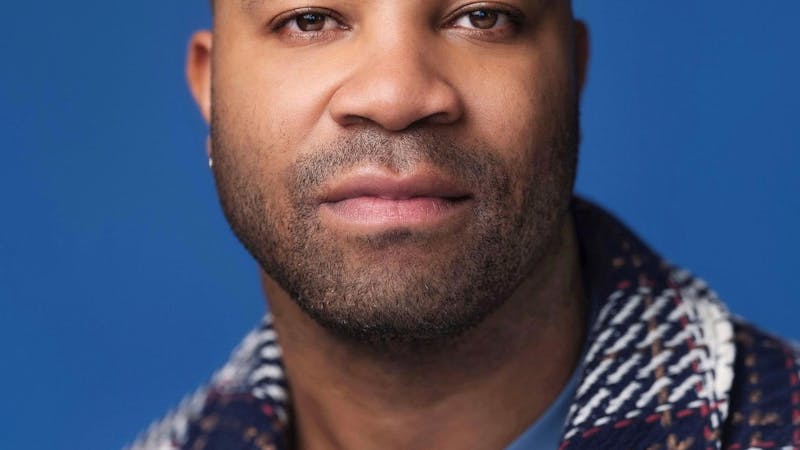‘Laughs in Spanish’ is true to its name

Review: ★★★★
In “Laughs in Spanish,” Latinidad, queerness and motherhood all intersect at Art Basel. The result is a witty and incredibly funny play that will leave you jajajaing throughout.
The play takes place in a Miami Art Gallery during Art Basel, a large annual art show. “Laughs in Spanish” centers on the lives of Carolina, an MFA painting student-intern, and her boss Marianna, who owns and manages the swanky Studio 6 art gallery.
“Laughs in Spanish” is running until March 17 at Stages, a nonprofit theater venue in Houston.
It was written by Alexis Scheer, a notable playwright who co-wrote Andrew Lloyd Webber’s “Bad Cinderella,” and directed by Rebecca Rivas.
The play opens in chaos — Studio Six has been robbed, and there are no paintings to display at the exhibition opening that evening. Thankfully, Carolina’s boyfriend Juan is a police officer and takes charge of the crime scene. Mariana’s mother Estella, a famous actress and screenwriter, and her assistant Jenny also serendipitously happen to be in Miami, and together, they help Mariana. The stolen paintings fade to the back of the audience’s attention, and we become entertained by a rekindled romance, a pregnancy announcement and a familial reconciliation.
“Laughs in Spanish” uses a minimalist and sparsely decorated set, yet still manages to be visually appealing. Hot pink walls and art-deco detailing grounded the play in Miami and gave the actors plenty of space to move across stage naturally. The costume choices also reminded the audience we were in Miami without being stereotypical or tacky. And, I’m still thinking of Mariana’s incredible bob.
One of the best aspects of “Laughs in Spanish,” though, was the use of Spanglish. Spanglish was celebrated within the play and incorporated naturally. They didn’t use it as the butt of any joke; instead, Spanglish helped to energize the script and create intimate moments between the actors and the audience. Latinx culture was celebrated throughout, and this was perhaps epitomized by the stories told by Estella, who delivered a rousing monologue exploring her relationship with her mother and her daughter and her experience emigrating from Colombia.
The script also did not shy away from confronting social issues and managed to do so in a sincere and genuine manner. This was the result of naturally incorporating these issues into the script, whether they concerned policing or health insurance. The play engaged robustly with questions about the contemporary art world and the accessibility of art — though I do feel that at times these critiques came across as ironic, given the fact that this play itself is guilty of being inaccessible as a result of the high ticket costs, ranging from $50-84.
One of the play’s only downfalls was the relationship between Mariana and Jenny. It felt like Mariana wasn’t given the opportunity to develop her queerness, making the relationship seem a little out of left field:. Across two scenes we went from Mariana denying to her mother that she was interested in anyone but men, to her making out with a woman.
While an explanation isn’'t necessary, Mariana isn’t able to express her identity in a way that doesn’t feel tacked-on. Instead, explorations of queerness in the play were limited to protracted kissing sequences. The result was that the relationship felt unbelievable, and there was not the same romantic connection that we witnessed between Juan and Carolina.
This was compounded by the little time that Mariana and Jenny spent actually talking to each other — as I mentioned before, they just kept making out. It felt almost voyeuristic, as if the kissing scenes were just included for shock value, rather than to actually develop their characters. Unfortunately, this aspect of the play left me very disappointed.
“Laughs in Spanish” is fittingly named — the audience was constantly cackling. Despite Mariana and Jenny’s disappointing relationship, the play’'s comedy was excellent. The actors gave dynamic performances, and their stage presence matched their scripted roles perfectly. It's an amusing and thought-provoking work that gently challenges and educates the audience —– yet we don’'t even notice.
More from The Rice Thresher

Acting like an athlete: Rice basketball alum takes on Broadway
Underneath Chadd Alexander’s Broadway costume, there’s ankle tape and wrist braces — same protective gear he wore as a walk-on basketball player at Rice, though now he’s performing eight shows a week in the ensemble of “Harry Potter and the Cursed Child” instead of running conditioning drills in Tudor Fieldhouse.
“Love Island” Season 7: A Messy, Magnetic Reality Show
It was my first time watching “Love Island,” and I get it now. There's a cycle to this show: you swear you won't get sucked in, you dismiss it as background noise, and then, one week later, you're canceling plans just to hear a group of twenty-somethings debate the meaning of the word "exploring." The truth is, “Love Island” has plenty of flaws. It’s too long, too produced and too ridiculous, but I'll be the first to admit it: I'm already planning to watch next season.
Review: “F1: The Movie” puts pedal to the metal
Joseph Kosinski, Claudio Miranda and Jerry Bruckheimer — the trio behind “Top Gun: Maverick” — return to high-octane spectacle with “F1,” a sports drama that blends spectacle with surprising humanity. It’s loud, stylish and frequently overwhelming, but it’s also one of the most engaging racing movies in years.


Please note All comments are eligible for publication by The Rice Thresher.